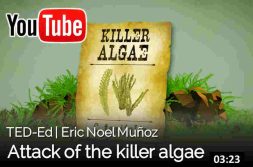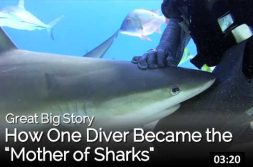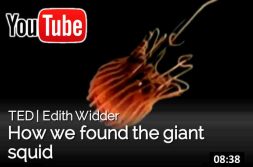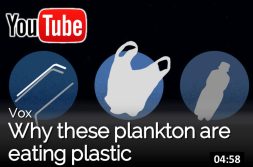Oceans
Questions
1. Have you ever lived by the ocean?
2. Are you an ocean or a mountain person?
3. What adjectives would you use to describe oceans?
4. What experiences have you had in your life with oceans?
5. What’s your favorite ocean animal?
6. What do you think is at the bottom of the ocean?
7. What are some dangers in the ocean?
8. What fun things can you do in the ocean?
9. What would you like to know about oceans?
10. What are some problems with the ocean?
11. In what ways are you like an ocean?
12. What are the most beautiful creatures living in the oceans?
Videos
As benign as it may look up close, the tiny seaweed Caulerpa taxifolia can wreak quite a bit of havoc on coastal ecosystems. This super algae is very adaptable; it also grows fast and spreads easily. Eric Noel Muñoz gives the details of this plant’s incredible invasion, shedding light on the risks of introducing invasive species into new ecosystems.
Lesson by Eric Noel Muñoz, animation by Eli Enigenburg.[/show_more]
Lesson by Eric Noel Muñoz, animation by Eli Enigenburg.[/show_more]
Category: Nature & Environment
Cristina Zenato needs only two words to describe sharks—nature’s masterpiece. A professional diver in the Bahamas, she loves sharks. Especially the Caribbean reef sharks that flourish around Grand Bahama Island thanks
[more]
in large part to her efforts to protect them. The sharks swim right up to the woman known as the Shark Dancer and nuzzle against her while she pets them like they’re dogs or cats. We take a dive off Grand Bahama Island with Zenato to learn how she built such a strong bond with these beautiful creatures.
[less]
Category: Nature & Environment
New videography techniques have opened up the oceans’ microscopic ecosystem, revealing it to be both mesmerizingly beautiful and astoundingly complex. Marine biologist Tierney Thys has used footage from
[more]
a pioneering project to create a film designed to ignite wonder and curiosity about this hidden world that underpins our own food chain.
[less]
Category: Nature & Environment
The immense swell of a tsunami can grow up to 100 feet, hitting speeds over 500 mph — a treacherous combination for anyone or anything in its path. Alex Gendler details the causes of these towering terrors and explains
[more]
how scientists are seeking to reduce their destruction in the future.
Lesson by Alex Gendler, animation by Augenblick Studios.
Lesson by Alex Gendler, animation by Augenblick Studios.
[less]
Category: Nature & Environment | Science
Keywords: Natural disasters | Oceans
Humankind has been looking for the giant squid (Architeuthis) since we first started taking pictures underwater. But the elusive deep-sea predator could never be caught on film. Oceanographer and inventor Edith Widder
[more]
shares the key insight — and the teamwork — that helped to capture the squid on camera for the first time.
[less]
Category: Nature & Environment | Science
Whales are the largest living animals that have ever existed on this Earth. A blue whale can grow to a whopping 110 feet in length, outweighing even the dinosaurs. But curiously their story begins from rather humble beginnings.
[more]
Here is the story of how whales became the giants of the sea.
[less]
Category: Nature & Environment
Microfibers, used to make things like yoga pants, are the ocean’s tiniest problem.
When you think of marine pollution, you might picture an oil-slicked seal struggling to breathe on a blackened
When you think of marine pollution, you might picture an oil-slicked seal struggling to breathe on a blackened
[more]
beach, or a turtle looping in circles with the plastic collar of a six-pack wrapped around its neck. In the past, those powerful images have generated interest and resources for fighting marine pollution, but now a new, much tinier threat is emerging.
Microplastics — meaning any plastic object smaller than five millimeters — constitute the vast majority of plastic particles polluting marine habitats.
Of those microplastics, a large share are microfibers: tiny strands of plastic that are woven into fabric used to make clothing. These fabrics, known by names like polyester and nylon, are cheap to produce, comfortable to wear, and since arriving on the market in the late 1940s, companies have been using more and more of them. Every time we do laundry, a small amount of microfibers are separated from clothes made from these materials. Since those pieces of plastic are extremely small, they’re able to make their way through water treatment centers and into marine resources. Once they reach marine habitats, the ocean’s tiniest creatures consume them, and microfibers work their way up the food chain. Eventually, they reach us.
Microplastics — meaning any plastic object smaller than five millimeters — constitute the vast majority of plastic particles polluting marine habitats.
Of those microplastics, a large share are microfibers: tiny strands of plastic that are woven into fabric used to make clothing. These fabrics, known by names like polyester and nylon, are cheap to produce, comfortable to wear, and since arriving on the market in the late 1940s, companies have been using more and more of them. Every time we do laundry, a small amount of microfibers are separated from clothes made from these materials. Since those pieces of plastic are extremely small, they’re able to make their way through water treatment centers and into marine resources. Once they reach marine habitats, the ocean’s tiniest creatures consume them, and microfibers work their way up the food chain. Eventually, they reach us.
[less]
Category: Nature & Environment






